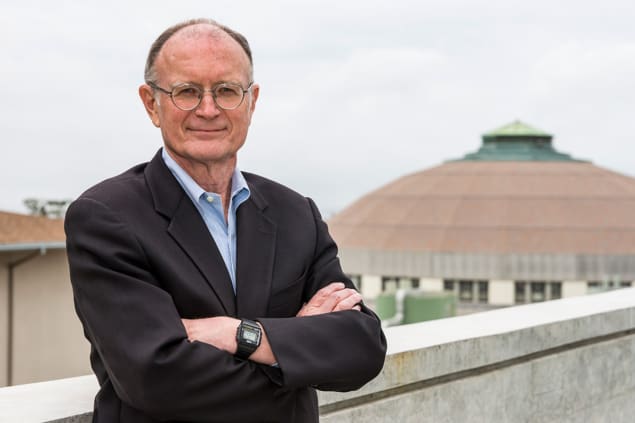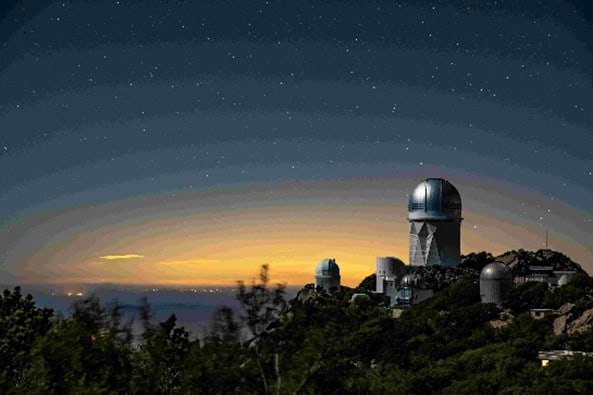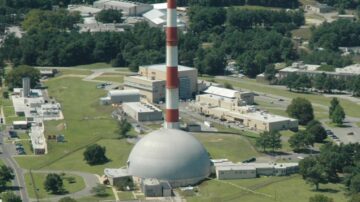Mike Witherell, director of the US Department of Energy’s Lawrence Berkeley National Laboratory, tells Joe McEntee why effective stewardship is essential for long-term research success

What is your main priority as director of Berkeley Lab?
The most important thing I do every day is listen carefully to the issues and problems preoccupying research leaders across the lab. I help them deal with any blockers that might be impeding the progress of their research and the development of our people, especially early-career scientists and engineers. Management’s role is to accelerate research, discovery and innovation across our four principal areas: discovery science; clean energy; healthy earth systems; and future science. We have spectacular views from Berkeley Lab and if my schedule permits I also do a campus “walk-around” — the exercise and the hills keep me fit. I run into lots of people – not just scientists – and learn stuff that I might not hear about just by sitting in my office.
You describe your remit as “stewardship of the laboratory”. What does that entail?
It’s about sustaining the high impact of our research, so that we’re as strong in 20 years’ time as we are now. That means co-ordinating strategic initiatives for different research areas into an integrated research strategy – ultimately, encouraging and fast-tracking cross-disciplinary collaboration within the lab.
Do you have any examples of this?
One is the Materials Project, a multi-institution, multinational effort to compute the properties of all inorganic materials and provide the data and associated analysis algorithms free of charge. To get there, we’re harnessing supercomputing and open web-based access to compute information on known and predicted materials as well as developing powerful analysis tools to design novel materials. This democratization of science could only be possible at a national laboratory.
What’s next on Berkeley Lab’s roadmap?
Federal funding for Berkeley Lab is $1.45bn this year – up from around $800m just seven years ago. World-class research requires world-class facilities and so we have a $600m upgrade to the Advanced Light Source (ALS-U), which will position our synchrotron user facility at the frontier of soft X-ray research for the next 30 years. I supervise the ALS-U project directly, given my experience running big accelerator projects when I was at Fermilab. Significant funds are also being invested in resilient infrastructure – electrical mini-grids, for example, and high-performance fibre-optic networks – as well as state-of-the-art administrative buildings and conference facilities. Berkeley Lab is being reimagined in front of our eyes.

What other physics-based projects are turning heads at Berkeley Lab?
I’ll pick out three – though there are many more. The Berkeley Lab Laser Accelerator Center (BELLA), for example, focuses on the development of compact laser-wakefield plasma accelerators with potential applications in high-dose-rate radiotherapy and, ultimately, high-energy physics. Our Accelerator Technology and Applied Physics division, meanwhile, has an ongoing collaboration with the SLAC National Accelerator Laboratory in Stanford to further increase the power and capacity of SLAC’s Linac Coherent Light Source, the US’s leading X-ray laser facility. Then there is the Dark Energy Spectroscopic Instrument (DESI), which is measuring the effect of dark energy on the expansion of the universe. The DESI research is half-way to completion, generating optical spectra for tens of millions of galaxies and quasars to eventually construct a 3D map spanning the nearby universe out to 11 billion light years.
How do you attract and ensure a diverse workforce?
We have more than 3500 full-time staff and my biggest concern is keeping hold of our best researchers and recruiting the next generation of rising stars. I want Berkeley Lab to be the place where researchers come to establish and accelerate their careers; where individual ambition aligns with diverse opportunities. While we can’t compete on remuneration with many nearby technology companies in Silicon Valley, the research teams at Berkeley Lab contribute to the nation’s biggest challenges. With this in mind, we prioritize an inclusive and supportive working environment, offering mentorship and professional development at all career stages. We continue to make progress in this regard: today, we have 10 women in our top 28 research leadership positions compared with four women in those roles seven years ago.
What does Berkeley Lab offer that isn’t possible elsewhere?
If you want to work on the biggest challenges in science then Berkeley Lab is the place to do it. We build cross-disciplinary teams to tackle some of the nation’s most pressing R&D problems – everything from energy storage and the circular water economy to quantum science, next-generation computing and the search for dark matter and dark energy. We’re able to address these challenges at a scale that is hard to match in a university setting thanks to our leading-edge experimental facilities and our breadth of scientific expertise.
How do you co-ordinate activity with other US national labs?
I meet with US government officials on a regular basis as well as with other DOE national laboratory directors at our quarterly retreats and on monthly Zoom calls where we’ll explore common challenges and opportunities for collaboration.
How is Berkeley Lab optimizing its engagement with industry?
We need scientists and engineers who engage closely with industry to know what industry needs – and, specifically, how our research priorities deliver wider societal and economic impact. Berkeley Lab’s National Energy Research Scientific Computing Center (NERSC) is a case in point, collaborating extensively with high-performance computing companies and suppliers. Elsewhere, the lab’s clean hydrogen R&D programme has close links with US trucking consortia, while the Joint BioEnergy Institute has yielded six bioeconomy start-ups to date. Then there’s our Cyclotron Road initiative, which offers entrepreneurial scientists and engineers a two-year fellowship programme. This is a funded path for early-stage start-ups in “hard tech” — physical hardware rather than software — to fast-track development of their applied research innovations.
- SEO Powered Content & PR Distribution. Get Amplified Today.
- PlatoData.Network Vertical Generative Ai. Empower Yourself. Access Here.
- PlatoAiStream. Web3 Intelligence. Knowledge Amplified. Access Here.
- PlatoESG. Carbon, CleanTech, Energy, Environment, Solar, Waste Management. Access Here.
- PlatoHealth. Biotech and Clinical Trials Intelligence. Access Here.
- Source: https://physicsworld.com/a/mike-witherell-seeking-big-impact-from-big-science/
- :has
- :is
- :not
- :where
- $UP
- 10
- 11
- 20
- 28
- 30
- 3d
- a
- Able
- About
- accelerate
- accelerator
- accelerators
- access
- across
- activity
- address
- administrative
- ago
- algorithms
- Aligns
- All
- also
- ambition
- an
- analysis
- and
- any
- applications
- applied
- ARE
- areas
- around
- AS
- associated
- At
- attract
- basis
- BE
- being
- Berkeley
- BEST
- Big
- Biggest
- Billion
- breadth
- build
- buildings
- by
- Calls
- Campus
- Capacity
- Career
- careers
- carefully
- case
- challenges
- charge
- circular
- clean
- clean energy
- click
- Close
- closely
- COHERENT
- collaborating
- collaboration
- come
- Common
- compact
- Companies
- compared
- compete
- completion
- Compute
- computing
- Concern
- Conference
- consortia
- construct
- continue
- contribute
- could
- Dark
- Dark matter
- data
- Date
- day
- deal
- deliver
- democratization
- Department
- describe
- Design
- developing
- Development
- different
- directly
- Director
- Directors
- discovery
- diverse
- Division
- do
- doe
- does
- early stage
- earth
- Economic
- Economic Impact
- economy
- effect
- Effective
- effort
- elsewhere
- encouraging
- energy
- engage
- engagement
- Engineers
- ensure
- entrepreneurial
- Environment
- especially
- essential
- establish
- eventually
- Every
- every day
- everything
- example
- examples
- Exercise
- expansion
- experience
- experimental
- expertise
- explore
- extensively
- Eyes
- facilities
- Facility
- fit
- focuses
- For
- four
- Free
- from
- front
- Frontier
- funded
- funding
- funds
- further
- future
- Galaxies
- generating
- generation
- get
- given
- Government
- Government Officials
- Hard
- Hardware
- Harnessing
- Have
- heads
- healthy
- hear
- help
- High
- high-performance
- Hills
- hold
- Home
- How
- HTTPS
- hydrogen
- i
- if
- image
- Impact
- important
- in
- Inclusive
- Increase
- individual
- industry
- information
- Infrastructure
- Initiative
- initiatives
- Innovation
- innovations
- inorganic
- Institute
- instrument
- integrated
- into
- invested
- issue
- issues
- IT
- ITS
- JOE
- joint
- jpg
- just
- Keep
- keeping
- Know
- known
- lab
- laboratory
- Labs
- laser
- lawrence
- leaders
- Leadership
- leading
- LEARN
- light
- links
- listen
- long-term
- lots
- Main
- make
- many
- map
- Match
- materials
- Matter
- max-width
- maximizing
- me
- means
- Meanwhile
- measuring
- Meet
- Mentorship
- might
- mike
- millions
- mind
- monthly
- more
- most
- multinational
- my
- National
- Nations
- Need
- needs
- networks
- next
- next-generation
- novel
- now
- observatory
- of
- offer
- offering
- Offers
- Office
- officials
- on
- ongoing
- only
- open
- opportunities
- optimizing
- Other
- our
- out
- path
- Peak
- People
- permits
- physical
- Physics
- Physics World
- pick
- Place
- Plasma
- plato
- Plato Data Intelligence
- PlatoData
- Point
- position
- positions
- possible
- potential
- power
- powerful
- predicted
- pressing
- Principal
- Prioritize
- priority
- problems
- professional
- programme
- Progress
- project
- projects
- properties
- provide
- Quantum
- quarterly
- R&D
- Radiotherapy
- rather
- recruiting
- regard
- regular
- reimagined
- remuneration
- requires
- research
- researchers
- resilient
- rising
- rising stars
- road
- roadmap
- Role
- roles
- Run
- running
- says
- Scale
- schedule
- Science
- scientific
- scientists
- Search
- seeking
- setting
- seven
- significant
- Silicon
- Silicon Valley
- Sitting
- SIX
- skies
- So
- societal
- Soft
- Software
- some
- Source
- spanning
- specifically
- spectacular
- Staff
- stages
- stanford
- Stars
- start-ups
- state-of-the-art
- Stewardship
- storage
- Strategic
- Strategy
- strong
- structure
- Supercomputing
- suppliers
- supportive
- Systems
- tackle
- teams
- Technology
- technology companies
- telescope
- tells
- tens
- than
- Thanks
- that
- The
- the joint
- their
- Them
- then
- There.
- These
- thing
- this
- this year
- those
- though?
- three
- thumbnail
- time
- to
- today
- tools
- top
- trucking
- true
- Turning
- Ultimately
- Universe
- university
- upgrade
- us
- us government
- User
- Valley
- views
- want
- was
- Water
- we
- web-based
- WELL
- What
- when
- which
- while
- WHO
- why
- wider
- will
- with
- within
- Women
- Work
- Workforce
- working
- world
- world-class
- x-ray
- year
- years
- yielded
- You
- Your
- zephyrnet
- zoom













